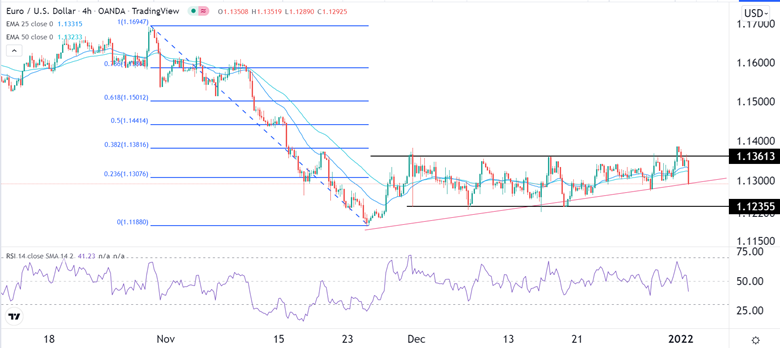Bearish View
Sell the EUR/USD and set a take-profit at 1.1188.
Add a stop-loss at 1.1350.
Timeline: 1-2 days.
Bullish View
Set a buy-stop at 1.1320 and a take-profit at 1.1400.
Add a stop-loss at 1.1250.
The EUR/USD pair declined sharply as the US Dollar Index jumped on the first trading day of the year. The pair declined to a low of 1.1290, which was the lowest level since December 29th. It has fallen by 0.85% from the highest level last week.
US Bonds Sell Off
The EUR/USD declined as US government bonds came under intense pressure. The yield of the 10-year government bonds rose by 0.10% to 1.60%. The yield of the 30-year rose by 0.10% to 1.99%. Bond prices have a negative correlation with yields. At the same time, the pair declined as US equities bounced back.
The performance of the pair is likely because of the potential divergence between the European Central Bank (ECB) and the Federal Reserve. Analysts expect that the two central banks will move in opposite direction this year. The Fed is expected to hike interest rates three times and end its quantitative easing policy this year.
On the other hand, the ECB is expected to be a bit cautious this year. Most analysts polled by Reuters expect that the bank will continue with its asset purchases program through the first quarter of 2023. It will not hike rates this year.
The EUR/USD pair declined after the relatively strong manufacturing data from the United States and Europe. According to Markit, the manufacturing sector in the two regions remained solidly above the expansionary zone of 50 even as the supply chain challenges continued.
Later today, the pair will react to the latest ISM manufacturing PMI data from the US and the German unemployment rate. Economists expect the data to show that the German unemployment rate declined to about 5.3% in December. France will also publish its preliminary jobs data for December.
EUR/USD Forecast
The EUR/USD pair declined sharply in the overnight session. It fell to a low of 1.1290, which is along the ascending trend line that is shown in red. It also moved slightly below the 25-day and 50-day moving averages. The Relative Strength Index (RSI) and MACD also tilted lower. The pair also moved below the 23.6% Fibonacci retracement level.
Therefore, after finding a strong resistance at around 1.1600 in December, there is a likelihood that bears will prevail in the near term. If this happens, the next key level to watch will be last year’s low at 1.1188.

